Nedd’s injury-laden 4000km run fascinated physios. His new plan may stun them
Nedd Brockmann became a national sensation in 2022 when he ran from Perth to Sydney. Now the man with the nation’s most famous haircut has set himself a new challenge.
By Luke Benedictus
It’s 3.45am in Sydney and beneath a tar-black sky, the air is still dank after a night of heavy rain. I’m standing between the puddles on an empty street waiting to break into a running track with Nedd Brockmann. I’ve promised not to disclose the exact location because, as his manager put it, “what you’re doing is technically illegal”. Luckily, Brockmann arrives early, barrelling around the corner on an electric bike. The good news, he explains as he hastily dismounts, is we won’t have to climb over the barbed wire. “Found a hole in the fence,” he says brightly. Squeezing through the hole, we scramble up a bank knee-deep with sodden undergrowth and there, stretched out before us, is the empty track. Brockmann strips down to T-shirt and running shorts, plonking a cap onto his bleached-blond mullet. All lean muscle and restless intensity, he performs perfunctory stretches for 20 seconds before wanting to get straight into it. The 25-year-old doesn’t hang about. He jabs a button on his watch and we start to run anti-clockwise around the track.
Brockmann likes to train this early because there are no distractions. Since his epic run across the country from Perth to Sydney, which catapulted him into the headlines in 2022, he gets plenty of selfie requests from strangers, not least because he sports possibly Australia’s most recognisable haircut. Yet there’s now an edge of urgency to his training. Just a few hours earlier on Instagram, Brockmann revealed his next big undertaking. On October 3, he will set out to run 1000 miles (1610 kilometres) around the 400-metre running track at Sydney Olympic Park in a bid to break the 1988 world record for the distance, which stands at 10 days, 10 hours and 30 minutes. Now that he’s gone public, I ask – through ragged breath – how’s he feeling about what sounds like an insanely tough challenge? Brockmann considers the question for several paces. “It’s scary,” he nods. “It’s f---ing violently scary.”
That fear comes from the knowledge that this 1000-mile run will push Brockmann’s mind and body to new limits. Which is pretty ominous, given he’s no stranger to extreme physical distress. On his run across Australia, Brockmann became a source of morbid fascination for physiotherapists around the world for his litany of injuries. There was the Achilles tendonitis, the tenosynovitis in his shin, the maggots infesting the cavity where his toenail used to be … yet Brockmann reckons this next ordeal will eclipse all that. “This will definitely be harder and more intense,” he says, without breaking stride.
What will make it so hard is condensing that mileage into such a narrow time frame. Brockmann will need to run more than 160 kilometres a day for 10 days straight. That’s the equivalent of almost four marathons a day, with no recovery in between. On a “good day”, he estimates, those 400-plus laps should take him about 17 hours; “a bad day could be 22″. The plan is to run through the night and then sleep in the grandstand during the heat of the day. A support team will be on hand to manage the inevitable battle wounds while trying to keep Brockmann fuelled with the 40,000-plus kilojoules he’ll need to sustain him each day. He acknowledges the record is “close to unattainable”, and that’s why he’s already training hard, sneaking into this eight-lane track because of its similarity to Olympic Park.
After 30 minutes, his watch bleeps and we change direction – a necessary measure, he explains, to avoid muscular imbalances from overusing one leg when rounding a bend. As we start to run clockwise, he nudges the pace up to 4.45 minutes per kilometre. A lapsed runner at best, I can only keep up for a few more laps before dropping out to let him push on alone. I’ve barely managed 7 kilometres; Brockmann is just warming up.
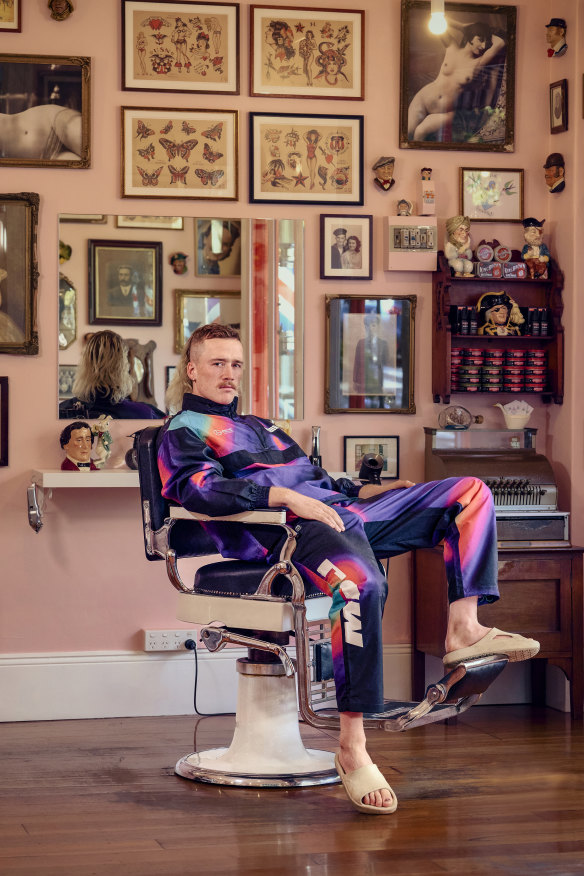
Nedd Brockmann at The Happy Sailors Barbershop, Redfern. Brockmann only listened to music for the final 10 kilometres of each day on his run across the Nullabor. “That was my reward for putting up with the 90 kilometres of not having it.”Credit: Nic Walker
Shoulders heaving, I stand on the sidelines and watch. Round and round Brockmann goes, grinding out lap after lap until distant traffic begins to thrum and the first birds start to chirrup through the gloom. The patter of his footsteps is Brockmann’s only soundtrack – most of the time he refuses to listen to music while he runs, viewing it as a form of cheating that tempers the challenge. And Brockmann doesn’t want to escape the pain. He wants to feel the strain of every kilometre, the throb of every muscle. On his run across Australia he’d only listen to music for the final 10 kilometres of each day. “That was my reward for putting up with the 90 kilometres of not having it.”
Away from the track, Brockmann doesn’t do walking pace either. He’s packed a lot into his 25 years. On the back of his transcontinental run, he’s already raised $2.6 million for a homeless charity, We Are Mobilise, and is determined to push that tally to $10 million. Last year, he started Nedd’s Milk, a drinks company that donates 20¢ from each bottle of chocolate milk or iced coffee sold to Mobilise. A feature-length documentary, Runn: The Nedd Brockmann Story comes out on Kayo and FoxSports this month. He consulted on the design of a new distance-running shoe, the Puma Mag Max, which will launch internationally in August and feature extra foam and cushioning after Brockmann was flown to Puma’s Boston HQ to share insights from his ultra-running experience. Having already published one bestselling memoir, Showing Up, a sequel, Fire Up (which I helped him write), will be released by Simon & Schuster in September. Finally, in October, following the 1000-mile run, he’ll launch “Nedd’s Uncomfortable Challenge”, another charity initiative that calls on people to pick an activity that forces them out of their comfort zone and that they’ll commit to doing for 10 days straight.
‘Everyone should pick a f---ing audacious goal and tell the world they’re going to do it … The moment it’s out there, the next six months of your life are sorted.’
Rewind four years and Brockmann wasn’t even a runner. In 2020, he’d just moved to Sydney from the family farm in Bedgerabong, a tiny town in western NSW, to begin an apprenticeship as an electrician. One night in his Randwick share house, he looked in the mirror and noticed he was starting to get “back fat”. His response was to start running. On that first outing, he managed less than 2 kilometres, but he kept returning for more. The distances increased rapidly, progressing to 5km, 10km, a full marathon. Brockmann still didn’t enjoy the actual running, but loved confronting what he describes as “the tipping point” – the moment the pain engulfs you and your body is screaming to quit. “But then you just sit in it for a little bit longer. Try to hold on as long as possible – one more step, another minute. If you train yourself to do that every single day for weeks and weeks on end, eventually it becomes ingrained and your ability to deal with much larger things increases.”
Brockmann is evangelical about the value of such moments, “the most pure form of being alive”. In August that year, he embarked on his first big challenge of running 50 marathons in 50 days. Shocked by the homelessness he saw around Central Station on his weekly trip to TAFE, he set out to raise money for the Red Cross. Every evening, after finishing work as a sparky, he clocked up the 42-kilometre distance, running endless laps of Centennial Park. The 50/50 challenge generated some social media buzz, due in part to Brockmann’s alarming capacity for punishment. On Day 12, for example, he tore a hamstring but kept going to finish – not just that marathon but all 50, nailing the final one in a ludicrously fast time of 2 hours 53 minutes. In the process, he raised $100,000 for the Red Cross.
Two years later, Brockmann set out on a new mission: to break the record for the fastest time to run across Australia. With his daily struggles documented on Instagram, the resulting odyssey transformed him into an unlikely national hero. He eventually arrived in Sydney after 3953 kilometres and 46 days on the road to find TV helicopters circling. Thousands packed the promenade at Bondi Beach to cheer him home.
Yet the Brockmann effect continued to percolate long after the Bondi crowd had dispersed. In Geelong, for example, five-year-old Charlotte O’Brien was inspired to start her own fundraising challenge by running one kilometre a day for 30 days (she raised $11,000 for a local charity providing free meals). When organisers of the 2023 Sydney Marathon sent out a questionnaire asking participants why they’d signed up, Brockmann’s name was repeatedly cited as inspiration. Last October, hundreds of people got up to join Brockmann on a series of 4am runs he hosted around the country from Newcastle to Adelaide.
What triggered this mass connection? While running across Australia is, of course, a monumental achievement, Brockmann was hardly the first to do it – at least 25 others had completed the feat before him. His much-vaunted mission to break the existing 43-day record for the distance was also a failure, given he fell short by three days. So why did the nation fall for Brockmann?
That’s a question I put to Chris Turnbull. The fact you probably haven’t heard of him underscores the conundrum of Brockmann’s cult appeal. A Sydneysider who manages his own engineering company, Turnbull also ran across Australia last year. Except that he did it in 39 days, smashing the existing record by four days and Brockmann’s time by a week. “People often say to me: ‘Did you go as fast as Nedd?’ ” the 40-year-old chuckles. Instead of resenting Brockmann’s celebrity status, though, Turnbull is an admirer. “What makes Nedd stand out is he sets himself these huge goals and throws everything out there very publicly. That’s extremely courageous.”
Turnbull also points to the speed of Brockmann’s athletic evolution. Most endurance runners are older – one US study into ultramarathons (classified as any distance over 42 kilometres) found the average participant’s age to be 43. These grizzled veterans tend to have worked up to longer distances, their joints and tendons acclimatising over time (Turnbull had “decades of running 100-plus kilometres every week”). Brockmann, by contrast, went from rookie to ultra-runner in under two years. “It’s astronomical what Nedd’s achieved, but it’s also more relatable,” Turnbull says.
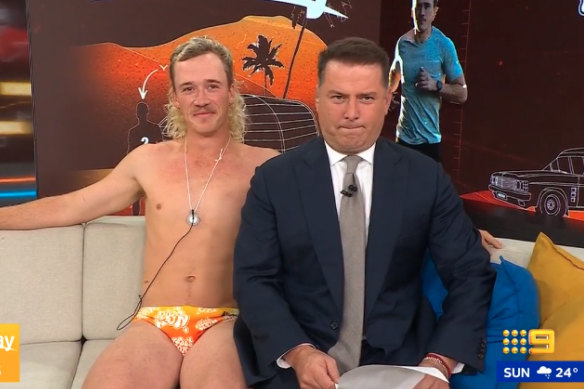
Brockmann strips down to chat with TV host Karl Stefanovic in 2022 about his running plans.Credit: @neddbrockmann/Instagram
Brockmann was relatable in other ways, too. A have-a-go tradie who loved AC/DC and meat pies, he memorably appeared on the Today show in a loud pair of budgie smugglers. The tone of his Instagram posts reinforced this knockabout persona. “The Nullarbor is going to cop it,” he told his followers on day eight of his 2022 run. “Stinging to do the old left foot, right foot across that little bitch of a highway.”
This light-hearted bravado was intercut with brutal intensity as Brockmann exposed the grisly reality of the run’s physical toll. Playing out on social media, these visceral snapshots gave his followers a voyeuristic insight into his daily plight. Watching Brockmann scrape his body off the bitumen to go again each day, it was hard not to become emotionally invested in his progress. His Instagram following exploded to 300,000 as he demonstrated that, however challenging things get, there’s always value in keeping going, putting one foot in front of the other. This message of gritty perseverance was hardly new. But its tone of defiant optimism and mental strength resonated loudly at that particular moment, coming as it did in COVID’s strange aftermath, when so many of us felt unsettled and adrift. It helped, too, that this display of plucky determination didn’t come from some SAS drill-sergeant type but a likeable country kid whose posts often showed him tearfully overwhelmed by the enormity of his challenge.
Ben Jhoty, head of content at Men’s Health magazine, suggests that, somewhere along the way, Brockmann became the accidental poster-boy for a more palatable form of 21st-century masculinity. Even his birth name, Jhoty says, was pitch-perfect – the cartoonishly macho “Brockmann” anchored by the monosyllabic thud of “Nedd”, a first name itself beefed up by that extra “d” and the implicit mythology of Australia’s favourite outlaw son. “He somehow manages to combine old-school archetypes of Aussie masculinity – the blond mullet, short shorts, moustache – with a thoroughly modern willingness to show vulnerability, admit weakness and embrace the possibility of failure,” he says.
“Brockmann is essentially a flesh-and-blood meme, yet one whose authenticity allows him to resist straightforward caricature. What you’re left with is a modern-day folk-hero tailor-made for the social-media age.”
Rattling along in a battered ute, the road feels like a mere scratch in the vast expanse of the plains. In the driver’s seat, Brockmann’s mother, Kylie, is giving me a lift to the family farm in Bedgerabong, a speck of a town a couple of hours west of Orange. Lean and blonde like her famous son, Kylie casually relates some of the hardships she and husband Ian have battled over the years on their farm. The droughts that ravaged their livestock. The floods that swamped the land. The wildlife plagues, including locusts, mice and feral pigs. “No,” she clarifies, “They were more like grasshoppers than locusts.”
I’ve come here to find the source of Brockmann’s grit; it soon becomes clear that it comes, at least in part, from his parents. Both grew up in the town of Forbes, 30-plus kilometres east of the farm. Ian’s father was a cattle-and-sheep farmer, while Kylie’s parents had a concreting business. When she was 26, her mother died from breast cancer, an event that would inform the type of parent she strived to be for her three children – Logan, Nedd and Mabel. “I wanted my kids to be resilient,” Kylie says. “Losing my mum made me realise my kids could lose me at any point. If that happened, I didn’t want them to fall apart without me. I wanted them to know they still had their siblings and skills to be able to pull themselves out of a hole.”
Kylie tried to insulate the kids from the “Cautious Cathy” side of her personality. She encouraged them to play outside all day long and not come to her complaining or crying unless they were “broken or bleeding”. Kylie points to a nearby field. When Nedd was about 11, she remembers seeing him fall off his motorbike there, after his front wheel got snagged in some wire. Once she realised the fall wasn’t bad, she forced herself not to rush out and comfort him. “I wanted him to learn that he was capable of looking after himself.”
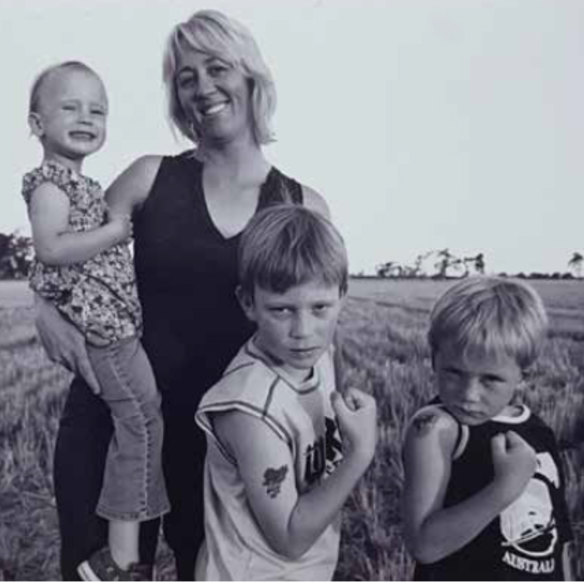
Nedd (right) 2005 with his mum, holding sister Mabel, and brother Logan, centre.Credit: Courtesy of Nedd Brockmann
The family home is a four-bedroom cottage, a modest property for a 4000-hectare cattle farm. A dog called Dixie snores happily on the front-room couch. I sit down for a cup of tea with Kylie and Ian, who’s just stepped off a tractor in a dust-covered work-shirt. Brockmann’s older brother, Logan, walks in and gives me a bone-crushing handshake. He works nearby as a builder (Mabel, the youngest, is a paramedic). The living room wall bears a photo of Brockmann as a freckle-faced kid with a steely gaze. From an early age, Kylie recalls, her middle son was always “really intense, very black and white”. At school, his insistence on calling out anything he considered unfair made him a bit of an outsider. “Nedd just can’t tolerate unfairness,” Kylie says.
After leaving school, Nedd returned to help his dad for a year on the farm. Labouring together, the son observed the father’s ceaseless toil – the crack-of-dawn starts, the long days feeding cattle, tending perimeter fences, doing what needed to be done. When I mention his son’s revelation, Ian goes quiet and I think he’s embarrassed. Then I see tears in his eyes. “I started feeding pigs when I was eight,” he shrugs. “It’s a way of living, I suppose. You’ve just got to go on and do it.”
Kylie and Ian were part of the seven-strong team that supported Brockmann on his run across Australia. Kylie describes it as “the most horrendous and the most fulfilling thing I’ve ever done”. What made it so difficult was watching her son in so much pain and being unable to rescue him – because he was voluntarily embracing the ordeal. “Nedd was intense as a kid and as an adult, he’s even more intense now. What scared me was I knew just how determined he was to finish that run. If he broke his leg, I knew he would’ve just plastered it and kept walking. And that level of commitment becomes scary. Because I knew that if he had to leave that run any other way than on foot, he was going to leave in a body bag. I was scared that if Nedd didn’t complete the run, he’d die trying.”
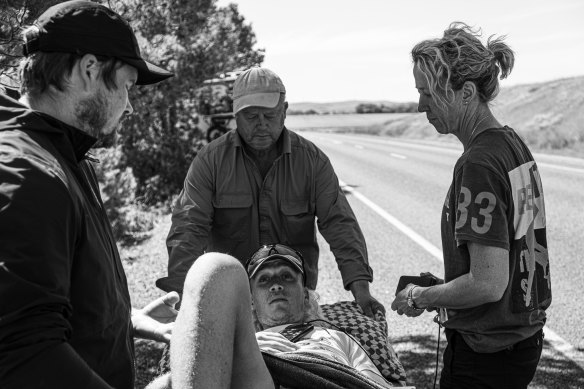
Brockmann with (left) physio Alex Bell, father Ian and mum Kylie on his run across AustraliaCredit: Courtesy of Nedd Brockmann
Two weeks after our pre-dawn run, I catch up with Brockmann at a cafe in Sydney’s Queens Park. Dressed in T-shirt, shorts and a Nedd’s Choccy Milk cap, he strolls in barefoot, his gold hoop earrings glinting in the morning light. He looks relaxed, which I put down to the presence of Dougie, his kelpie/border collie cross.
As we take our drinks outside, he volunteers why he’s upbeat. “When I saw you last, I was second-guessing myself – I don’t think I believed I could do it,” he says of his looming challenge. “And it’s really, really hard to put yourself out there if you don’t think you can do something. Especially when I pride myself on being a person of my word.” The self-doubt had been triggered by social-media flak, with some in the ultra-running community rubbishing Brockmann’s chances of breaking the 1000-mile record given the brevity of his running CV. He took the criticism hard, feeling his integrity was under attack. “I started over-analysing it because all these people were casting doubts on me. I started going, ‘Maybe I can’t do it’. But after about four days of copping that, a lot of crying, and a lot of trying to understand my own head, I was like: ‘Hold up – I’m in this now. I’m going to get it done.’ ”
On a physical level, Brockmann’s confidence was bolstered when he glided through a 70-kilometre training run with ease. But he also credits a recent trip with Mobilise for sharpening his focus. In Adelaide they visited Catherine House, a refuge for homeless women, to launch Mobilise Pay, a new initiative in which single mothers get support packages of up to $10,000 through funds Brockmann raises. “This woman who’s been in the program got up – she was crying – and she goes to me: ‘Never stop doing what you’re doing.’ Her saying that reminded me why I do what I do.”
Self-belief restored, Brockmann is doubling down on his preparations. He describes his new mindset as “burn the boats”, a phrase often credited to Hernán Cortés, the 16th-century Spanish conquistador who set out to conquer the Aztec Empire. According to legend, before marching into Mexico’s interior, Cortés discovered some of his troops were plotting to desert. Cortés’ response was to burn his entire fleet of ships – then push on or perish. “So it’s like, burn the boats. You’re here now and the only way home is straight through everyone,” Brockmann says. “And, for me, that ‘straight through’ is running 160 kilometres a day. I don’t think most people are willing to put themselves in that position where they have no plan B.”
The goal of breaking the record consumes his life, leaving little room for much else, including relationships. Living alone in a rented flat in Randwick, he’s been single since his split with girlfriend Jemma Griffin at the end of last year. “I love being on my own at the moment,” he concedes. Indeed, Brockmann leads a monastic lifestyle, getting up each day by 4.30am (often earlier). He takes daily cold showers to strengthen his resolve. He doesn’t drink and chooses his meals by their nutritional value (“so I’ll choose the bowl of oats not the bacon roll”). He hits the gym and runs the set number of laps prescribed by his running coach, Matty Abel.
Any vices? Racking his brain, he confesses he’s probably on his phone too much. But since ditching his job as an electrician to become a full-time ultra-runner/philanthropist/chocolate-milk tycoon, social media is a necessary evil. That said, he reckons his weekly screen time barely amounts to two-and-a-half hours a week. So how does he switch off? “Right now, from the moment my brain is awake, there is no ‘off’ button with thinking about this goal,” he says. “I do not do anything without it in my head. I cannot escape it until it’s done.”
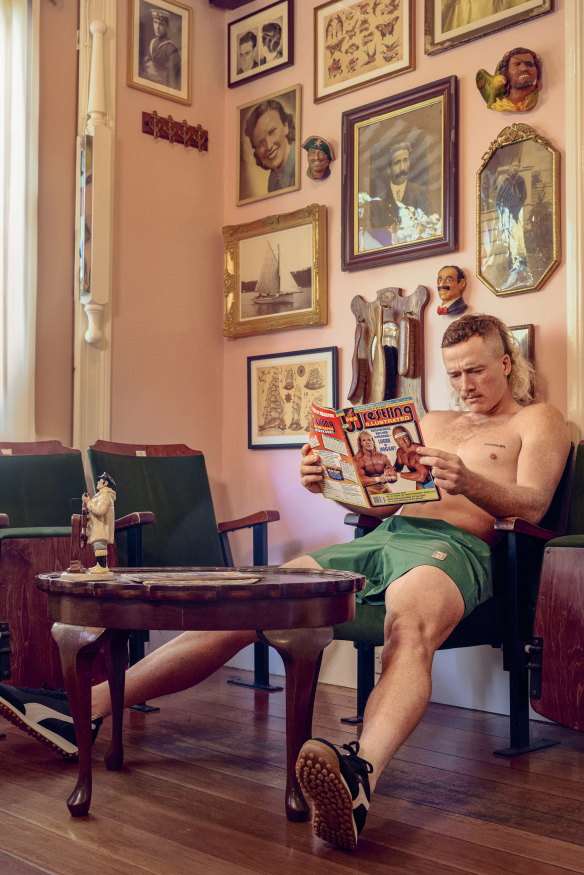
“I don’t think most people are willing to put themselves in that position where they have no plan B,” Brockmann says.Credit: Nic Walker
It sounds almost as exhausting as the running. “No, it’s great,” Brockmann insists. “Everyone should pick a f---ing audacious goal and tell the world they’re going to do it. Because the moment it’s out there, the next six months of your life are sorted. You might never achieve that thing. But at least you’re attacking it and there’s purpose in your life because you’ve chosen to do something. That’s the way I’ll always be ’til the day I drop.”
Dougie is getting restless, so we move into the park and find a bench. Before I sit down, Brockmann dries the seat for me with his T-shirt then double-checks the sun isn’t in my eyes. While his slightly manic directness can seem gruff at times, he’s considerate, too, with his actions seemingly informed by a rough-hewn chivalry.
Born in 1999, Brockmann qualifies as Gen Z. Yet his outlook seems in stark contrast with the stereotypes levelled at this demographic – that they’re flaky and work-shy, with unrealistic expectations of work/life balance. Zoomers, after all, are credited with giving us “quiet quitting”, while Brockmann called his first book Showing Up.
I suggest that while those in his generation are often labelled “snowflakes”, he’s more like a giant hailstone made of rock-hard ice. “Yeah, I want to be,” he says. “And I want to keep on callusing it, too.” Yet being a callused hailstone must be isolating when the rest of the world is comparatively soft. Do Brockmann’s standards mean he’s often disappointed by the weak-willed nature of others? “I hold people to account,” he admits. “I don’t judge them, but I will say how it is.”
To illustrate, Brockmann tells how he recently arranged to meet a mate in Bondi for a run at 6am. He duly turned up outside the friend’s house at 5.50am. At 5.58am, with no sign of his mate, Brockmann called his mate’s number – no reply. The friend turned up at 6.05am. Brockmann demanded an explanation. “He just goes, ‘Oh, I’m really sorry.’ And I was like, ‘Yeah, you should be, because my time is my time and I could already be 10 minutes into this run, so never do that again, to me or to anyone. You can let yourself down, mate, but do not let other people down.’ ”
I can understand this hardline response on one level – it’s based on mutual respect. On the other, bloody hell … I can’t imagine it makes him popular. “I think people are thirsty for it,” he counters. “People don’t know how to do it in their own lives. So that’s why there’s this attraction to someone who can run around an oval for 70 kilometres.” As he speaks, I’m watching Brockmann keep his dog in line with sharp whistles and clear instructions. Each time, Dougie obediently responds, tail wagging. He’s a happy dog, partly because he’s so well-trained. As Dougie bounds across the grass to cavort with a passing dalmatian, I start to wonder if maybe Brockmann is right. Maybe we’d all fare better if we governed ourselves by stricter guidelines, refused to submit to our self-indulgent whims.
Not long after, I find myself signing up for my first half-marathon in years. Part of me is inspired by Brockmann’s spartan philosophy, with its emphasis on personal striving and accountability – his personification of poet Robert Browning’s line that “a man’s reach should exceed his grasp”. Yet another part of me can’t help but worry for him. How sustainable is all this, really? (And I’m not just thinking of his knees.)
It’s clear there’s a price to pay emotionally as well as physically. Brockmann tells me about suddenly breaking down at a recent shoot in Melbourne for Puma. “I just burst into tears, there was a lot of crying.” Does he put that down to the colossal pressure he’s under? “Yeah, it’s really hard to explain, but my mind is just working in a really …” he tails off for a second. “I think I analyse things a lot. Like, everything’s a lesson. Everything’s an opportunity to be better, to do more.”
I say goodbye and walk away through the park. Glancing back, I see Brockmann throwing a ball for Dougie in the autumn sun. He looks happy. That’s not always his default state, yet what do you expect when your entire belief system is configured around seeking discomfort and testing your limits to breaking point? It’s a hard path Nedd Brockmann has chosen. Then again, the last thing he wants is an easy life.
To read more from Good Weekend magazine, visit our page at The Sydney Morning Herald, The Age and Brisbane Times.